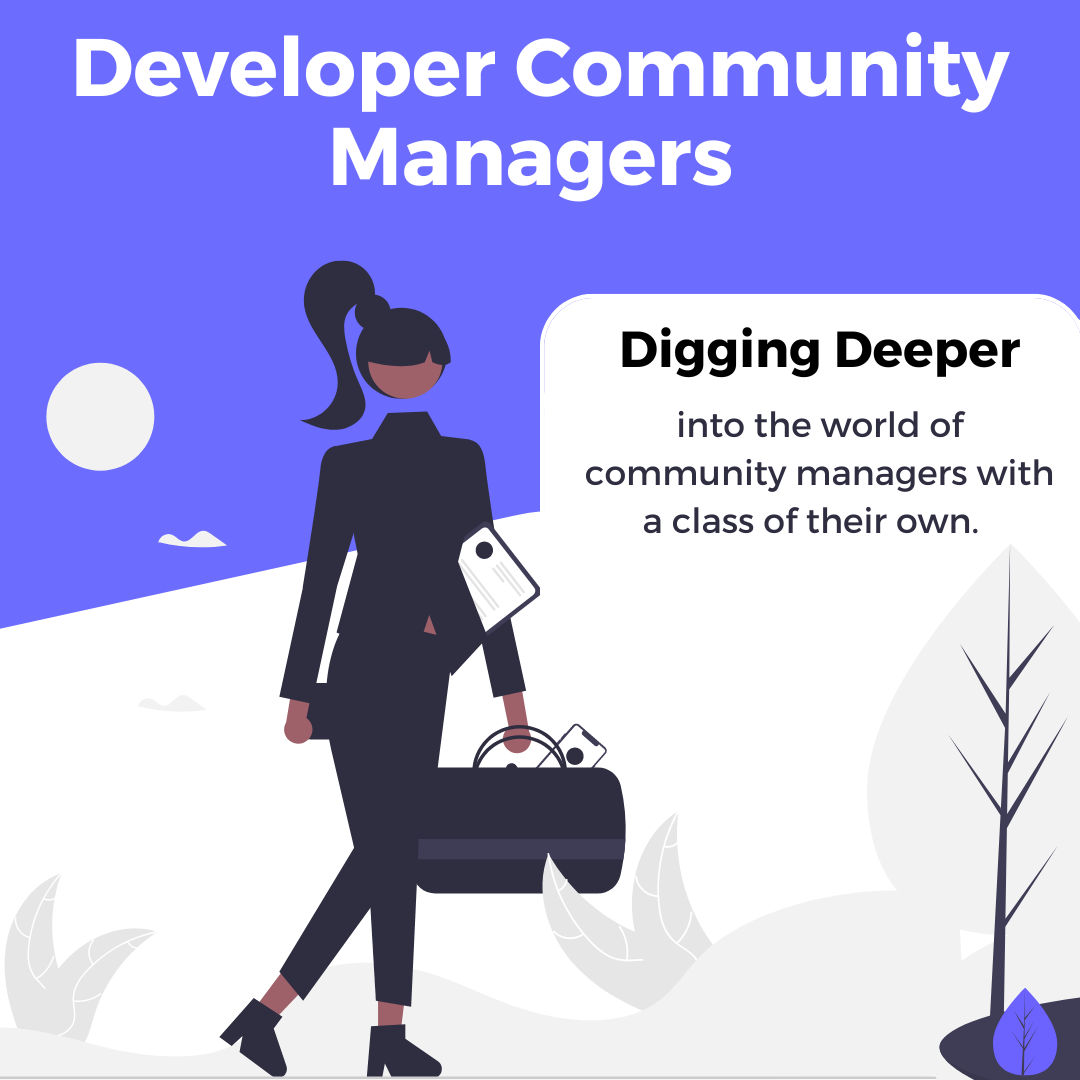Developer Community Managers

I have a feeling, this particular blog will get a few more eyes than the other ones out there — why? Because of the recent increase in the need for community managers everywhere! Community managers have existed for a long long time. We humans have always lived in smaller communities or tribes if you consider the millennial era or factions. From politics to religion, sports to technology, the community is what binds people together and helps them grow as individuals supporting a larger cause.
But I am more sure you all already know all this. Let’s pick up the shovel and understand one of the foundational roles in DevRel — Developer Community Managers.

Who are developer community managers?
Developer community managers are folks who lead the growth and nurturing of their target developer community through various initiatives. They are usually experienced as developers in their field, although not necessarily, and act as a liaison between developers and the organisation. Generally, these roles are generally taken upon by community advocates who are extremely passionate about the product and the community built around it. Hence these folks often interface with the developer relations, marketing and product teams, with a multitude of responsibilities.

What is the need for a developer community manager?
For any community, there’s always an initial communication gap between the experienced and the new individuals. Without a certain level of moderation and motivation, it becomes difficult for people to get accustomed to and contribute to the community. Even for experienced folks, it is necessary that someone listens to them and understands their needs and accordingly works towards facilitating that — very similar to a job of a manager.
Ever since the COVID-19 pandemic, there has been an accelerated adoption of remote working and now the need for digital innovation has been more than ever. Every community tends to look for new ways to boost their collective spirit, now more than ever. These groups or communities of developers need guidance and more creative people to lead and understand their needs.
Especially while working remotely, developers often lose touch with other developers outside of an organisation and miss out on the work that might excite them too. Community managers make sure this doesn’t happen. They are skilled individuals which often share the same skills as developers and are strikingly motivating 🔥.

Which skills are needed to make a great CM?
Being a developer community manager, one is expected to have both hard and soft skills.
- Hard skills might include the focus and understanding of the goal of the community. Whether it is a tool, product or a new age technology, understanding the gist of it is generally needed. Alongside that, the ability to structure programs around community engagement are also desirable depending on the needs of the community.
- Soft skills for community managers are mainly focused on the inherent ability to sense the feeling of the community alongside organisational abilities and competency in the management of time and resources.
Some of the other skills that most community managers generally have possessed include being a great mediator and having amazing great team-building skills. CMGR’s are expected to assess a multitude of situations and apply feedback to any given process. It’s a no-brainer that community managers are communication experts and people who possess great emotional and social intelligence. A huge part of community management is communicating effectively. Community managers are expected to be versatile, flexible and adaptable.

How CMGRs track community growth?
Metrics are one of the most debatable topics in the world of DevRel. As we move more and more into the digital world of community management, it is getting harder to track the actual growth of the community. This is because as compared to the physical interactions, the digital interaction of the community can be diversified so heavily that tracking it becomes really difficult. When it comes to metrics it’s very important to understand that one can measure only the things that they manage.
Understanding the success of your community and pinpointing where that success lies can be difficult but then one of the most basic ways to measure success is by engagement and response. Having said that, there are a few metrics that generally help a CMGR get a better picture of how the community is responding to the current strategies.
- Addition of new members: A direct indicator of growth and increased interest in the community/ product
- Retention of existing community members: Indicator of engagement and the value community members are finding being a part of it
- Daily/weekly/monthly active users (DAUs, WAUs & MAUs): A decent indicator of engagement, but generally should be considered alongside other parameters affecting the behaviour of the community
- Average session length: This generally shows the interest people are taking in understanding the happenings of the community.
- Net promoter score (NPS): It is a metric used in community experience programs. NPS measures the perception or loyalty people have towards the company/ product. NPS scores are measured with a single question survey and reported with a number from -100 to +100, a higher score is desirable.,
- Customer effort score (CES): Customer Effort Score is a type of satisfaction survey used to measure the ease of service experience with an organization. It asks people to rate the ease of using products or services on a scale of “very difficult” or “very easy.”
- Percentage of user-generated content(UGC): Arguably one of the best indicators of a community’s success. The more UGC, the more it shows that people are genuinely interested in contributing and are taking interest in the community.
Another point one would like to consider is understanding the “degradation point” — a point at which in the coming years, your strategy might become irrelevant towards maintaining the relationships it currently does. This directly ties into building scalable programs or refactoring existing ones to accommodate a newer section of the community. As a community manager, one should always work on building long-lasting relationships and communities.

The 90:9:1 Rule
While structuring community programs, there’s one rule that always grabs my attention. The 90:9:1 rule. This rule essentially means that
- 90% of the community members will never be interacting (lurkers), they’re just consumers of information and make a perception about the product around the conversations that are happening around. Assume this similar to how we see reviews on online products before we buy
- 9% of the community members actually interact (promoters), ie. asks questions and raise issues
- 1% of the audience members are advocates. They answer questions, interact with people and help them explore your product.
Targeting these members is very different in general. We need to have specific strategies for everyone here. Each section of the community has different requirements and it is necessary to understand their needs before making any decision that affects them.

Various Faces of the Community Managers
Marketing & Support
This is the most important part of community management. The marketing and support aspect of community management does not consist of forming those catchy tags in social media, but rather communicating new developments with the community effectively. Making sure they are aware of the new happenings alongside resolving their questions, forming discussions and making sure everyone is heard.
Partner and Ecosystem Development
Apart from growing the user community, community managers also care about growing the developer and contributor community for their projects. Contributor programs, especially, involving open-source projects for an enterprise, are either employed by large users of the software, or they are engineers working for companies selling the product. Maintaining advisory board memberships, user group meetings, and generally ensuring that your project remains a strategic priority for the companies investing in it is an important part of the job.

Developer Enablement
While growing a developer community, community managers are responsible for ensuring that the developers who are actually contributing to the project, can get their job done effectively, and with ease. This can be made sure by creating proper contribution guidelines and making sure it is understood by everyone involved in the community to have a flawless workflow with fewer barriers. Creating workflows around how PRs are reviewed is also a great way to ensure the contributions are taken seriously, encouraging the community members in their efforts.
Product and Release Management
There are a lot of variables and teams involved in releasing a complete product, especially in the open-source world. A community manager is ideally positioned to mediate the internal conflicts that can cause hindrance in delay or disruption of an efficient workflow. Community managers usually tackle this by presenting a roadmap that includes all types of teams involved with the project. Communication is key. 🔑
Product Strategy
Strategy is everything when it comes to determining the success of the community or product in general. Understanding the community needs and communicating them effectively with the concerned teams to make a clear pathway to achieve those are some of the many responsibilities of developer community managers. This becomes especially important in companies that have an intersection of community and enterprise products. Making the case of prioritising the community while ensuring the customers are happy is one of the trickiest situations faced by community managers.

To sum it all up, developer community managers can’t be easily defined based on their needs — hard or soft skills. It’s so much more than that. At the core, it’s all about effective communication and having a clear thought process to understand the priorities, rather than the specificities. Developer community managers usually are developers at some point too, although not necessarily, they definitely share the same passion and motivation — to make the product better, to make the community thrive, to help everyone involved.
